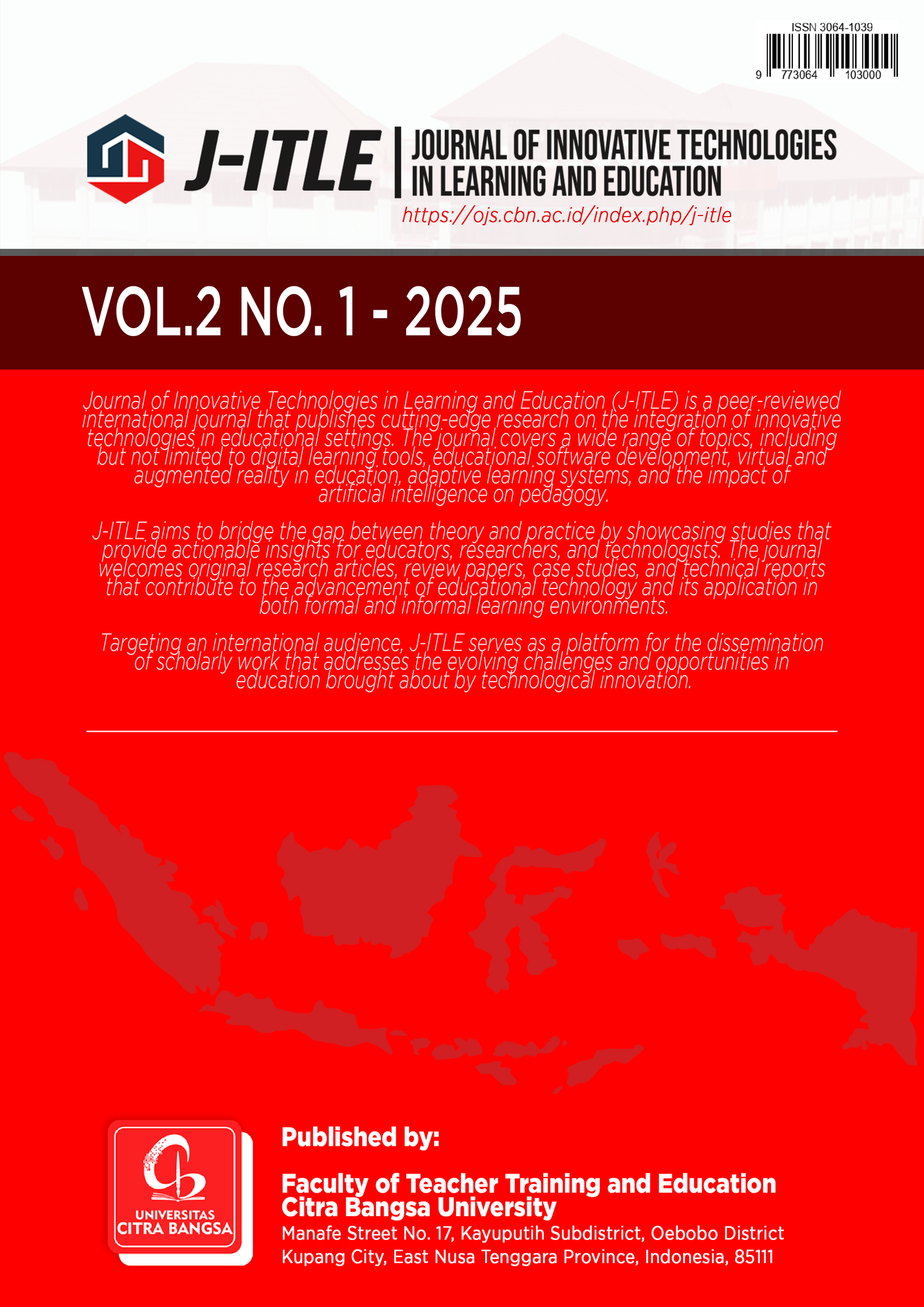THE EFFECTIVENESS OF THE APPLICATION OF TEACHMINT LEARNING MEDIA BASED ON THE SAVI LEARNING MODEL TO IMPROVING IPAS LEARNING OUTCOMES
Main Article Content
Abstract
The aim of this research was to determine the effectiveness of utilizing Teachmint media integrated with the SAVI learning model in improving Integrated Science and Social Studies (IPAS) learning outcomes among fifth-grade students of SD GMIT Oepura, Kupang City. This research employed a quantitative approach with a Quasi-Experimental design. The sample was selected using a purposive sampling technique, consisting two classes: Class V-A as the experimental group and Class V-B as the control group. The data collection technique consisted of a test comprising 20 multiple-choice questions. The application of the Direct Instruction model with a lecture method in the control class resulted in an average pre-test score of 50.48 and a post-test score of 62.62, indicating an improvement of 12.14 points. Meanwhile, the SAVI learning model supported by Teachmint media in the experimental class achieved an average pre-test score of 55.24, which increased to a post-test score of 87.86, reflecting an improvement of 32.62 points. The research findings were reinforced by hypothesis testing and t-test analysis of the post-test scores from both the control and experimental groups. The Independent Sample Test produced a significance value (2-tailed) for the t-test for Equality of Means of 0.000, which is less than the threshold of 0.05. This result confirms the acceptance of the alternative hypothesis (Ha), indicating a significant effect of the SAVI model supported by Teachmint media on IPAS learning outcomes, particularly for the theme "Getting Acquainted with Our Earth," among fifth-grade students of SD GMIT Oepura, Kupang City.
Article Details

This work is licensed under a Creative Commons Attribution-NonCommercial-NoDerivatives 4.0 International License.
License Terms
All articles published in the Journal of Innovative Technologies in Learning and Education (J-ITLE) are open access and licensed under a Creative Commons Attribution-NonCommercial-NoDerivatives 4.0 International License (CC BY-NC-ND 4.0).
Key Terms of the License:
-
Attribution:
- Users are free to share, copy, and redistribute the material in any medium or format under the following conditions:
- Proper attribution must be given to the original authors and source (the Journal of Innovative Technologies in Learning and Education), including a link to the license and an indication if changes were made.
- Attribution should not imply endorsement by the authors or the journal.
- Users are free to share, copy, and redistribute the material in any medium or format under the following conditions:
-
Non-Commercial:
- The material cannot be used for commercial purposes. Any usage must be solely for educational, research, or personal purposes.
-
No Derivatives:
- If you remix, transform, or build upon the material, you may not distribute the modified material. The work must remain in its original form without alterations.
-
Open Access:
- All articles are freely accessible to the public, ensuring that research is widely available and disseminated without barriers.
-
Author Rights:
- Authors retain significant rights to their work, including:
- The right to use their published work in their lectures, presentations, and further research.
- The right to share their work on institutional repositories, personal websites, and scholarly collaboration networks with appropriate attribution.
- Authors retain significant rights to their work, including:
-
Reuse and Distribution:
- Articles published under this license can be shared widely, provided they are not altered, sold, or used for commercial gain, and proper credit is given to the original authors and the journal.
-
License Notifications:
- Users of the content must provide a link to the full license terms whenever they use the material, and must clearly indicate if any changes were made to the original work.
By submitting a manuscript to J-ITLE, authors agree to these license terms, ensuring that their research is freely available and widely disseminated while maintaining control over how their work is used.
References
Afif, K., et al. (2021). Pengembangan Bahan Ajar Interaktif Bermuatan 6C (Critical Thinking, Creative Thinking, Collaboration, Communication, Character, dan Citizenship) pada Materi Pola Bilangan Kelas VIII. Jp3, 16(1), 284–293. Retrieved from http://www.riset.unisma.ac.id/index.php/jp3/article/view/9830
Afifah, et al (2022). Efektivitas Model Pembelajaran SAVI dalam mata Pelajaran IPA di Kelas V Sekolah Dasar. Jurnal Pendidkan Dasar. 2(2), h. 211- 219.
Astuti, Rahmani. (Penerjemah) (2002). The Accelerated Learning Handbook. Bandung : Kaifa.
Harefa, Edward et al. 2024. Buku Ajar Teori Belajar Dan Pembelajaran. Jambi : Sonpedia Publishing Indonesia
Nitte, Yulsy. (2024). Kosu and implementation of local wisdom character values in West Amarasi, Indonesia. The International Journal of Social Sciences World (TIJOSSW), 6(1), 170–175. Retrieved from https://www.growingscholar.org/journal/index.php/TIJOSSW/article/view/445
Shoimin A. (2014). Model Pembelajaran Inovatif dan Kurikulum 2013. Yogyakarta: Ar-Ruz Media.
Subekti, S et al. (2019). Pengaruh Model Pembelajaran SAVI terhadap Hasil Belajar Siswa. Jurnal Pendidikan.
Sufyadi, et al. (2021). Pembelajaran paradigma baru. Jakarta: Pusat Asesmen dan Pembelajaran.
Sugiyono. (2015). Metode Penelitian Pendidikan, Pendekatan Kuantitatif, Kualitatif dan R&D. Bandung: Alfabeta.
Suyatno. 2009. Menjelajah Pembelajaran Inovatif. Sidoarjo: Masmedia Buana Pustaka.

